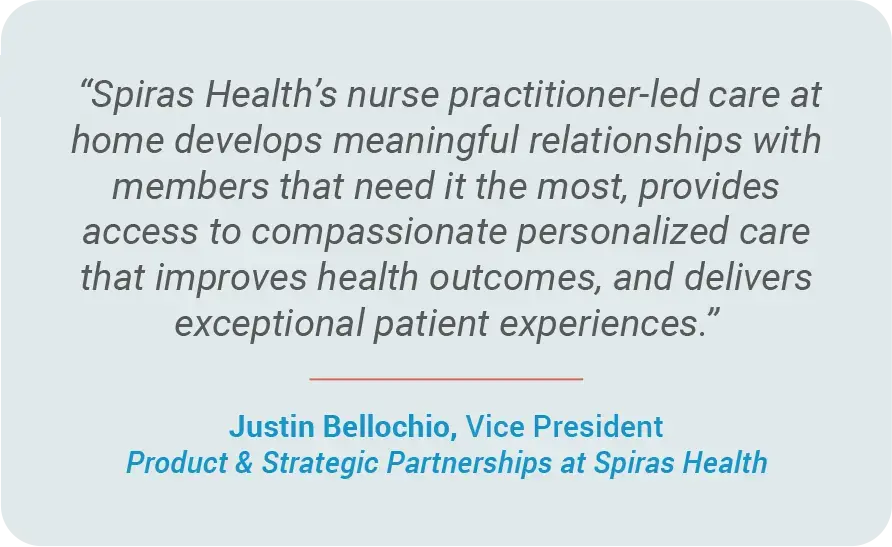Focusing on Health Equity and the Patient Experience to Improve Medicare Star Ratings
By Spiras Health | March 28, 2023

When it comes to Health Plan Star ratings, tenths of a point matter! Knowledge of the full value of Star ratings to a health plan and insights highlighting areas of risk to Star ratings makes a difference. Further, a member-centric corporate culture supporting a strategy focused on Star ratings will help a health plan attain tenths of a point & much more.
Star ratings drive bonuses with big money at stake for health insurance companies who focus on Medicare members.
From 2015 through 2021, the annual bonuses to Medicare Advantage (MA) plans rose from $3 billion to $11.6 billion.1 MA enrollment continues to grow as does the opportunity to both the societal and financial benefit from improving the lives of members. The bonus revenue from Star ratings also provides MA plans with additional capital to invest in supplemental benefits and innovative care models that enhance members’ care experience and access while improving health plan quality. Unsurprisingly, over 70% of all MA members are enrolled in plans with ≥4 Stars.2
Investing the Star quality bonus into continuous quality improvement pays; health plans have found that reinvesting into clinical offerings results in continued high performance. And high-performing plans tend to retain their ratings, while those without capital to reinvest find it difficult to improve Star ratings.
Source: View source data at cms.gov
The Value of Star Revenue
Star ratings will impact future revenue in two ways – through both a bonus applied to risk adjustment as well as the percentage applied to rebates. Risk adjusted revenue can increase by 5% for plans receiving ≥4 Stars. This equates to $50 per member per month on average. In certain qualifying counties the revenue impact can double, with bonus factors shifting from 5% up to 10%.
The rebate paid to the health plan is calculated as a percentage of the difference between a plan’s bid and the CMS-defined benchmark. A plan’s Star rating determines the rebate percentage. Plans with ≥4.5 Stars receive 70%, 3.5 – 4 Stars receive 65%, and ≤ 3 Stars: 50%.3
The chart below shows how the bonus revenue and rebate value significantly impact a plan’s profitability and competitiveness. Comparing the same plan of one hundred thousand members at different Star ratings demonstrates a difference of $75M in annual revenue.
Example Annual Revenue Impact
3 Star & 4.5 Star Plans
Patient Experience, Complaints, and Access Account for 58% of the Star Rating in Measurement Year 2023
CMS uses Star measures to monitor and reward health plan performance that improves Medicare members’ health outcomes. Assessing the year-over-year trend of measures identifies areas of importance for CMS, driving innovation and reform within the healthcare system.
The bar graph below represents the Star measure weighting categories, highlighting those that have increased in importance over the last four years. Both the “Patient Experience and Complaints” and “Access” categories have increased in weighting by 50%.
The ‘Patients’ Experience and Complaints’ category includes the CAHPS survey, which accounts for 1/3 of the overall Star rating. The survey measures a member’s perception of the quality of care they receive, how accessible the care is, the customer service experience, and an overall health plan rating.
Measures on complaints and the appeals process, access to interpreter and TTY services, and member disenrollment contribute an additional 1/3 to the overall Star rating.
Whether responding to a survey, making a complaint, or appealing a coverage or payment decision, the perception members have of the care and value they receive from health plans significantly impacts Star ratings.
Prepare for Increased Focus on Health Equity and More Balance Amongst the Weight of the Outcome & Process Measures in 2024 and Beyond
Advancing health equity is the first pillar of the 2022 CMS Strategic Plan 4 and a goal of the CMS National Quality Strategy.5 As part of this strategy, CMS introduced a transition from the current reward factor to a health equity index (HEI) for the 2025 measurement year.
The HEI will reward Medicare plans for providing excellent care to underserved populations. It applies measure data from the prior two years to assess performance among those with specified social risk factors (SRFs); dual eligibility, low-income subsidies, and disability.
The HEI would significantly impact the Star ratings as the factor is applied directly to the overall Star rating and the Part C and Part D summary ratings. To forecast the impact, CMS conducted a simulation of the HEI using the 2021 Star rating data. The results demonstrate risk to plans’ Star ratings: 13% of MAPD contracts would lose one-half star and just 2% would gain one-half star.6
To help secure and improve Star ratings in future years, plans should increase their focus on health equity today.
CMS has also proposed changes for measurement year 2024 that would lower the weight of the measures within the “Patient Experience and Complaints” and “Access” categories from 4 to 2. However, these measures would still account for 30% – 40% of the overall Star rating.
In addition, the two 3x-weighted Health Outcome Survey (HOS) measures that assess a members’ longitudinal perception of their physical & mental health over a 2-year period will return in measurement year 2024. CMS continues to focus on “hearing the voice of patients” when evaluating the quality of care provided through the survey based CAHPS & HOS measures.
The changes proposed for 2024 and beyond reflect CMS’ attention to ensuring that the weight of these Star measures best represent the impact they have to improving patient quality of care.

Members with complex conditions require personalized care to optimize their health and patient experience
The Star measures evaluate the health plan’s ability to improve members’ health and well-being. This can be difficult to accomplish for a member of average health. But with the added burden of complex conditions like COPD, CHF, and diabetes, members are forced to navigate a healthcare system that can feel confusing and overwhelming.
Health disparity barriers, like social isolation and lack of transportation, further limit access to necessary care. These complexities increase the risk of emergency room visits, expensive hospitalizations, and negative patient experiences. Members can feel disengaged from their care, hopeless about the future, and fearful for their life.
These members with chronic conditions and complexities create risk to health plan Star performance. Optimizing members’ perception of their health & well-being under these difficult circumstances is challenging, and much of the experience seems out of the plan’s control.
Delivering an innovative care model built to transform the care experience for this population can change lives, reduce costs for the member and the plan, and elevate health plan Star Ratings.
Care-at-home, guided telehealth, 24/7 nurse access, remote patient monitoring, and omnichannel engagement all work together to enhance the patient experience.
The Spiras Health Model
Spiras Health’s personalized care-at-home model overcomes access barriers through in-person visits that develop meaningful relationships and deliver personalized care plans managing members’ conditions through multi-modal touchpoints and coordinated care.
Cherokee J, a 67-year-old plan member, remarked, “I credit Spiras Health for keeping me out of the hospital for medical issues over the past three years. They have taught me how to control my symptoms and manage early signs and symptoms.”
Members like Cherokee are engaging with clinicians who are helping to create a more positive experience with the healthcare delivery ecosystem. Their optimized Spiras in-home care results in 95% of Spiras patients rating the Spiras clinical experience 5 out of 5 Stars and 94% of Spiras patients indicating they are highly likely to re-enroll in the health plan due to care from Spiras. Members express hope and are empowered to make the changes that will improve their health – the kind of changes that create positive perceptions and move hard-to-influence Star measures for plans.
The opportunity to transform care delivery to match the evolving Medicare Star Ratings is here!
To learn how to offer Spiras Health to your members with complex needs, contact us using the form below
- www.kff.org/medicare/issue-brief/spending-on-medicare-advantage-quality-bonus-program-payment-reached-10-billion-in-2022/
- www.cms.gov/newsroom/news-alert/cms-releases-2023-medicare-advantage-and-part-d-star-ratings-help-people-medicare-compare-plans
- www.cms.gov/files/document/2023-star-ratings-technical-notes.pdf
- www.cms.gov/cms-strategic-plan
- www.cms.gov/Medicare/Quality-Initiatives-Patient-Assessment-Instruments/Value-Based-Programs/CMS-Quality-Strategy
- public-inspection.federalregister.gov/2022-26956.pdf

 Prev
Prev